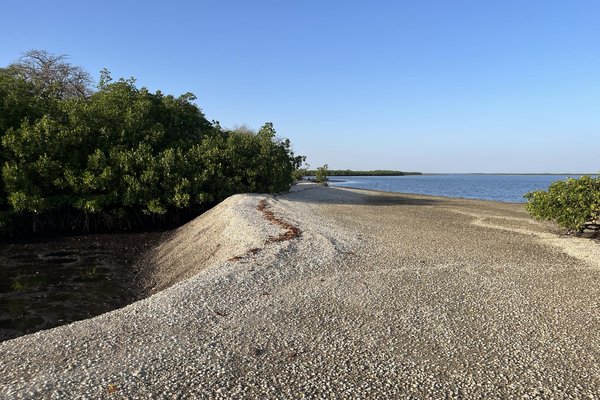Senegal
Saloum Delta
The Saloum Delta is representative of a traditional coastal lifestyle of shellfish gathering and fishing in brackish water.
The site holds numerous shellfish mounds, some several hundred metres long. Humans produced them over 2,000 years and form a structure of reclaimed land. Several of them hold funerary sites (tumuli).
Community Perspective: The shell mounds are impressive - if you can see them within this wide area. They can best be reached from Toubacouta (Jarek, Els), where boat rides are on offer. Another option is Djiffer (Thomas), although more geared towards the (uninscribed) natural features of the Delta. Squiffy reports of an entirely natural encounter in Fathala Forest (within the core zone).
Site Info
Official Information
- Full Name
- Saloum Delta (ID: 1359)
- Country
- Senegal
- Status
-
Inscribed 2011
Site history
History of Saloum Delta
- 2011: Advisory Body overruled
- IUCN recommended no inscription - did not meet any natural criteria - should go for Ramsar/World Biosphere instead. ICOMOS were ok with cultural inscription. Some WHC members supported IUCN, some (e.g SA, Egy) wanted referral, some wanted deferral. Secret ballot 11 against 10 was in favour of referring the Natural nomination for more studies on Bird life.
- 2011: Inscribed
- Inscribed
- Type
- Cultural
- Criteria
- iii
- iv
- v
Links
- UNESCO
- whc.unesco.org
All Links
UNESCO.org
- whc.unesco.org — whc.unesco.org/
Community Information
- Community Category
- Cultural Landscape: Relict
Travel Information
Recent Connections
-
Oceanic Dolphins
"Atlantic Hump-backed Dolphin (Vulnerab…
-
Misleading WHS Names
The name suggests a natural site, but i… -
Necropolises
"The Saloum tumuli shell mounds, at lea…
Connections of Saloum Delta
- Geography
-
-
On National Border
With Gambia: a. . The Wiki entry for Gambia's Niumi NP states "The park is contiguous with Senegal's Delta du Saloum National Park and Biosphere Reserve." b. The AB eval for Saloum states "it also includes the coastal marine area from the mouth of the Saloum River in the northwest,to the Gambian border in the south." -
Atlantic Ocean
-
Estuary
"Within the estuary component of the property.... " (IUCN eval) -
River deltas
"the Saloum Delta region is close to 5,000 km2, of which the actual delta represents approximately half. The property comprises the western, southern and central parts of the delta, the most humid and most typical, with a surface area of approximately 800 km2" (AB ev) -
Sahel
" in a Sahelian subtropical environment" (OUV)
-
- Trivia
-
-
Role of Women
Shellfish gathering and processing for trade is today performed by women, while the men devote their time to fishing, without it being possible to know when this division of labour occurred." (AB eval) -
Cultural sites taking up an entire island
"Together with a great many bolons or brackish channels,they form a dense network encompassing over 200 main islands and islets" (AB eval) -
Largest cultural WHS
145,811 ha
-
- History
-
-
Shell Mounds (Middens)
"With its numerous shell mounds, associated landscapes and the presence of a rare and well-preserved ensemble of funerary tumulus mounds, the Saloum Delta provides exceptional testimony to a coastal lifestyle" (OUV)
-
- Ecology
-
-
Mangroves
"The property is defined by three main ecosystems: the mangrove forest, which is the most extensive.." (AB ev) -
Oceanic Dolphins
"Atlantic Hump-backed Dolphin (Vulnerable) is cited as present in the DDS, with 100 animals out of an estimated population size of several thousand" (IUCN ev)
-
Flamingos
"Other notable bird species occurring in the DDS include Lesser and Greater Flamingo" (IUCN AB ev) -
Bird Migrations
East Atlantic Flyway (birds)
-
- World Heritage Process
-
-
Controversial at inscription
IUCN recommended no inscription - didn't meet any natural criteria - should go for Ramsar/World Biosphere instead. ICOMOS were ok with cultural inscription. Some WHC members supported IUCN, some (e.g SA, Egy) wanted referral, some wanted deferral. Secret ballot 11/10was in favour of referring the Natural nomination for more studies on Bird life.
-
Cultural sites rejected for Natural criteria
It was proposed as a Mixed nomination in 2011, but the natural criterion (X) was referred and never followed-up. -
First sites filling gaps cited by ICOMOS
hunting-gathering-fishing (2011)
-
- Human Activity
-
-
Hunter-gatherers
"The Saloum Delta is an eminent example of traditional human settlement. It represents a lifestyle and sustainable development based on the gathering of shellfish and fishing" (Crit v) -
Artificial Islands
"The numerous shell mounds in the Saloum Delta are generally well preserved and they sometimes have imposing dimensions. They are direct testimony of sustainable and very ancient socio-economic practices. Over the centuries, they have led to the formation of numerous man-made islets" (AB eval) -
Reclaimed land
"All the shell mounds built up over a 2,000 year-long cultural process have formed a physical structure of stable islets and reclaimed land within the Saloum Delta." (OUV)
-
- Constructions
-
-
Tombs
"In some cases, for an important individual, a funerary structure using a baobab circle forms a sanctuary (tomb of the griot Wolof Bak Kawl on Dioron Boumak)." (AB ev) -
Necropolises
"The Saloum tumuli shell mounds, at least the largest of them, are concentrations of a small number of tombs and fulfil the role of necropoli and permanent sacred spaces." (AB ev) -
Tumuli
Shellfish tumuli
-
- WHS on Other Lists
-
-
Ramsar Wetlands
Saloum Delta NP 1984
-
- Timeline
-
-
Built in the 8th century
"In the Saloum Delta, carbon 14 dating of the shell mounds dates the oldest at up to 400 BC. The creation of tumuli on certain large shell mounds occurred later. It started in the 8th century AD"
-
- Science and Technology
-
-
Recorded cultural discoveries
"As early as the 15th century, the Saloum shell mounds were mentioned by the first Portuguese explorers, such as Dinis Diaz. In the early 16th century, Valentim Fernandes described in his Description of the African West Coast, how the molluscs were processed by the inhabitants and sold commercially in locally made earthenware pots" "The shell mounds were long considered natural accumulations. It was only in the 1930s that their manmade origin was fully proven, and their funerary role brought to light. The first archaeological excavations in the Saloum Delta were carried out in Dioron-Boundaw and Dioron-Boumak in 1939." (AB ev)
-
- WHS Names
-
-
Misleading WHS Names
The name suggests a natural site, but it is a purely cultural site focused on the tradition of building shell mounds (and using some of them as burial places). -
Named after a River
Saloum River
-
News
No news.
Recent Visitors
Visitors of Saloum Delta
- Alexander Barabanov
- Ali Zingstra
- Ask Gudmundsen
- Atila Ege
- Boj
- Bram de Bruin
- CynthiaSam
- David Marton
- Els Slots
- Eva Kisgyorgy
- George Gdanski
- GerhardM
- Gilles
- Iain Jackson
- Jarek Pokrzywnicki
- jonathanfr
- Joyce van Soest
- Loic Pedras
- Luis Filipe Gaspar
- Maciej Gil
- Malgorzata Kopczynska
- Morodhi
- Nihal Ege
- Olli-Pekka Turunen
- palka25
- Philipp Leu
- Pink Bunny
- Piotr Wasil
- Roger Ourset
- Roman Bruehwiler
- Squiffy
- Stanislaw Warwas
- Szucs Tamas
- Thomas Buechler
- Thomas van der Walt
- tony0001
- Vanessa Buechler
- Westwards
Community Reviews
Show full reviews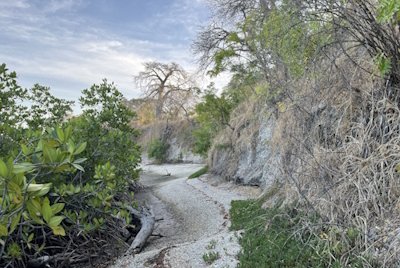
Like the Omo Valley, people visit the Saloum Delta mostly for A (birding) while it is inscribed for B (the tradition of shellfish gathering and the historical shell mounds). Fortunately, unlike Omo, Saloum is well-documented, with clear maps. The place to start your boat journey is the laidback town of Toubakouta, which lies conveniently close to the Gambian border if you have plans for an onward journey. The town can also be reached from Dakar or even Saint-Louis within a day.
My B&B offered a ‘menu’ of no less than 24 tours and other activities, but my eyes already stopped at #2: a late afternoon boat trip to L’île aux coquillages. So at 4.30 pm, boat guy Ibu and I stepped into the large wooden, motored pirogue and went out. The waters of the Saloum River tributaries are calm (though the Delta is tidal). It is a good area for fishing: one of the other guests had caught two large barracudas the other day, which we had for a delicious dinner in the evening!
Close to the town, you can see wooden racks standing in the water. These hold nets for the artificial production of oysters. But the oysters also grow naturally on the roots of the mangroves, which are the predominant type of vegetation along the river banks. We saw several women collecting these molluscs during low tide. The mangroves also provide honey, which is sold by the locals to tourists.
After a short interlude …
Keep reading 0 comments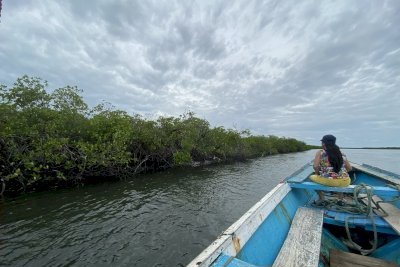
We visited the Saloum Delta in September 2021 with a private car from Dakar, it was a day trip, all the way to the small fishing community of Djiffer at the end of the presqu'Ile. It took us a bit more than 3 hours. The car was arranged by our guesthouse (La Villa 126, a fantastic place, Awa is the lovely manager there +221776790286, the direct contact to the driver is +221775386362 Abdoulaye) and reasonably priced. Djiffer is surrounded by water on both sides, and due to global warming and beach erosion, lots of beach shacks and fishermen's houses have been destroyed recently. We drove straight through the center to the fishing port where our driver/guide made some arrangements for the boat trip to the Saloum Delta. Gasoline was organised, the price then fixed (50 Euros), and soon we discovered the birdlife and mangroves in the direction of Falia & Dinouar villages. We did not see any shellfish mounds, but stopped on the way back in the picturesque fishing village of Joal-Fadiouth, there you are actually walking on real shells. Just at the pedestrian bridge is a seafood restaurant, it makes a good stop for fresh garlic shrimps or a grilled fish. The "Baobab Sacré" (on google map) makes another great stop on the way back to Dakar, as well as "Old Rufisque" which is in itself a Tentative site of UNESCO.
Keep reading 0 comments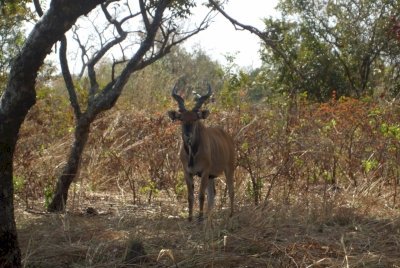
The Land Rover came to a stop. Just ahead a roan antelope emerged from the brush and started to step delicately across our path. I was just pulling out my camera when Maria, our guide, suddenly screeched something about giraffes. The antelope panicked and fled as our driver Amadou gunned the engine and swerved the truck left off the track. I ducked back inside the vehicle as it jounced over the dry earth, breaking through stands of high, brittle grass. Two more Land Rover appeared alongside just as we ploughed to a halt in front of a covey of surprised looking Cape Giraffes. They stared thoughtfully down their noses at us, as though unsure what to make of us. Then, with a switch of their tails they made their decision and, as one, turned and ambled off through the trees.
A bit of an odd review this. It’s a review of a visit to a World Heritage Site that did not go anywhere near any element that got it inscribed in the first place. The Saloum Delta is a decent sized chunk of mangrove creek landscape and a hotspot for West African wildlife, particularly migratory birds. The mangrove creeks of Senegal and Gambia are particularly representative of the landscape of these countries and my partner and I had been converted to enthusiastic bird-spotters on a trio of walks and early-morning boat trips on the south side of the River Gambia. Yet the Saloum Delta is inscribed solely on Cultural …
Keep reading 0 comments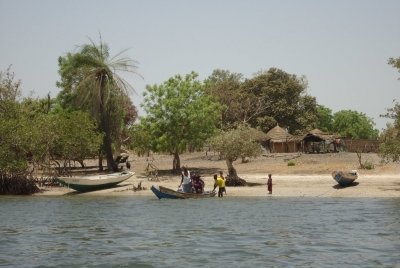
Some practical info (site visited in April, 2018). The best place to start exploration of the area is a small town of Toubacouta (frequent local buses or sept-place from Kaolack, main road Kaolack - Karang - Gambian border is a basic transportation artery from Senegal to Gambia). Toubacouta has some descent number of hotels / hostels, shops, restaurants so its an ideal base for visiting the area.
The only way to reach Saloum Delta is to take a boat. There are usual two types of trips offered by local people: southbound trip from Toubacouta to Sipo village (typical Delta village located on artificial mounds made of millions of shells). In the village - around 30 huts you can visit any place as well as buy local products (honey, souvenirs). Trip include visiting some canals with mangrove vegetation as well as local birds.
Another trip is a northbound one to the place called "Ile au coquillages diorum". It is also an artificial island made of shells but much higher that Sipo. It also looks much older as there are baobabs trees that seems to be several hundred years old. The island is currently uninhabited. There are some hiking paths (unmarked)
Both trips costs 15.000 CFA each and takes 3-4 hours depending on the time spent in the village / island. During the trips you should have your own protection against the sun (boats are uncovered). Take also plenty of water and some food with you.
Comparing to other places in Senegal …
Keep reading 0 comments
